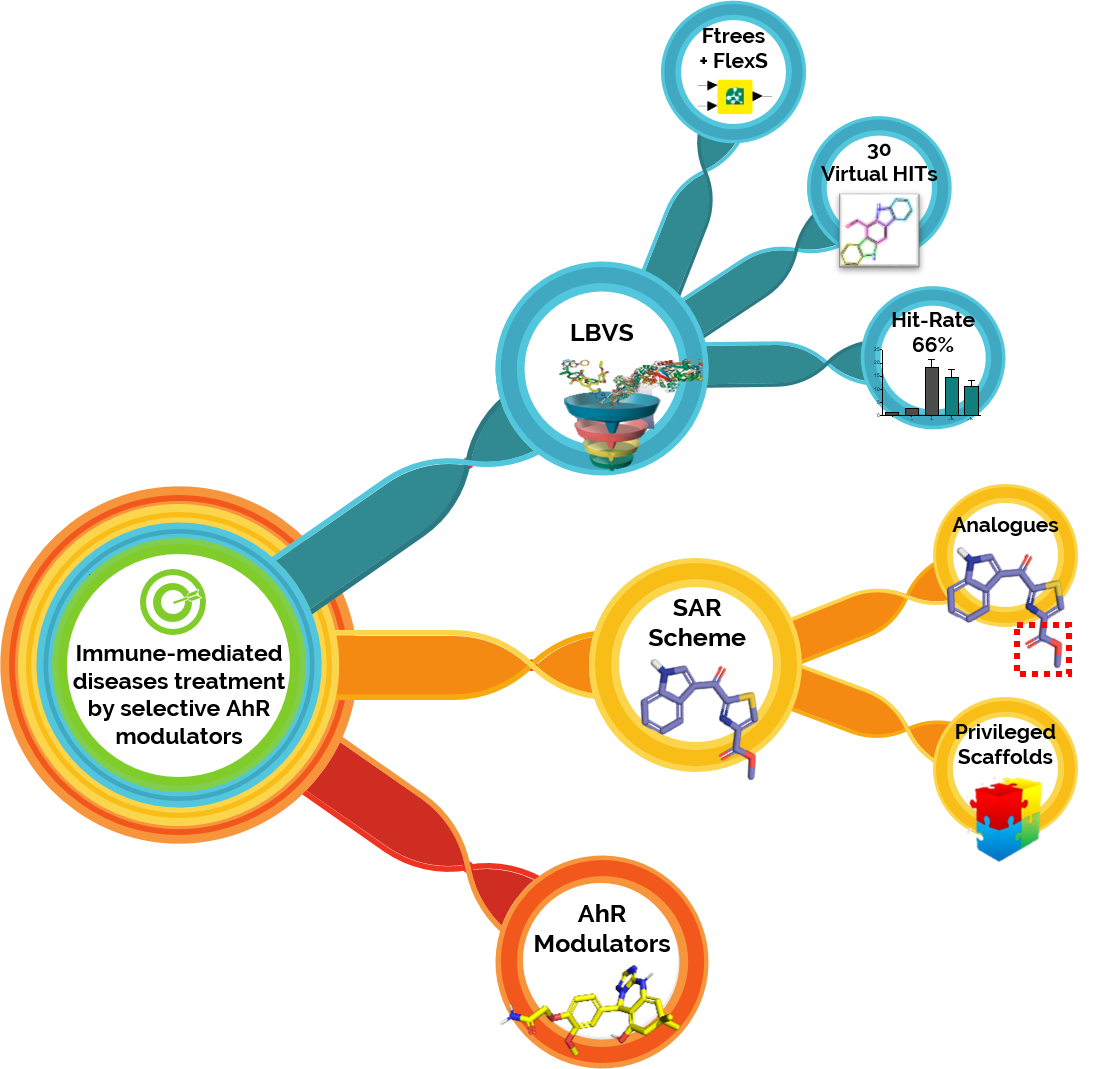Aryl hydrocarbon Receptor (AhR) represents a network hub of genomic and non-genomic signaling pathways, which connects environmental factors to immune system. In physiologic conditions, this receptor mediates important effects on immune system, cancer development and cell cycle regulation. Interestingly, AhR-mediated effects are species-, tissue- and ligand- specific, leading to extend the paradigm of functional selectivity also for this transcription factor. In other words, different ligands can induce, selectively, a specific receptor conformation and this, in turn, correlates with the transcription of specific set of genes influencing the final biologic effect. Although during last years some efforts have been devoted to the characterization of AhR signaling pathways, various factors hamper the search for new AhR modulators endowed with immunomodulatory profile. Firstly, being modulated by a broad spectrum of synthetic and natural compounds possessing different scaffolds and physicochemical properties, AhR is defined as a promiscuous receptor. At the same time, a scarce knowledge about endogenous ligands and effects exerted exists, with the receptor being still orphan. Moreover, the high toxicity of most potent AhR ligands along with the lacking of a 3D structure of the Ligand Binding Domain (LBD) obstructs the characterization of molecular basis underlying AhR interaction. In this scenario, in the last 12 months I have successfully applied BioSolveIT package to identify new small molecule AhR modulators endowed with good affinity versus AhR using a ligand-based approach. Three non-toxic L-Tryptophan (L-Trp) metabolites, namely L-Kynurenine (L-Kyn, ki = 21.6*103 nM), ITE (ki = 3 nM) and FICZ (ki = 0.07 nM), have shown interesting pharmacologic properties being able to affect disease tolerance and to interfere with experimental autoimmune disorders. Considering the increasing interest for this target, these three ligands were chosen as references for the search of new AhR modulators. A Ligand Based Virtual Screening (LBVS) was carried out using FTrees and FlexS in an integrated fashion. Best selected virtual HITs were then purchased and tested through luciferase reporter assays and results were used to measure screening performance. The satisfactory obtained Hit-rate enabled the validation of LBVS protocol paving the way to a Hit-to-Lead optimization strategy. Hence, previously validated homology models were used to dock most promising compounds employing SeeSAR in an attempt to enhance compound potency through the design of analogues. Overall, the applied strategy has allowed the identification of two potent AhR modulators which are currently being tested in functional assays to prove their applicability to treat immune diseases.
After 1 year, Daniela has achieved the following goals:
- Validation of Ligand Based Virtual Screening protocol. Aiming to identify new AhR modulators with structural similarities to the 3 selected AhR ligands, a LVBS campaign was carried out applying FTrees and FlexS using Knime Interface. Specifically, a library of about 300,000 commercially available compounds was firstly submitted to FTrees using the 3 ligands as queries. Then, the best 500 molecules, according to similarity score, were used as input for FlexS calculation employing best docking poses for each L-Trp derivative. 10 virtual HITs for each reference molecule were then selected and tested through biological assays. 20 out of 30 compounds resulted able to transactivate AhR with a global hit rate of 66%, which validates the applied protocol. ITE and FICZ outperformed the other queries from a qualitative and quantitative point of view, respectively. L-Kyn resulted the less efficient ligand to use, as foreseeable considering its lower affinity versus AhR.
- Unraveling structural determinants accounting for AhR modulation. Considering that no selected compound improved transcriptional activity over ITE, the most promising HITs were selected to carry out an analogue-based drug design strategy devoted to build a Structure Activity Relationship (SAR) scheme. Interestingly, most of the identified 30 HITs showed some common scaffolds allowing to expand the SAR scheme. Hence, previously validated homology models (HMs) of AhR LBD were used to dock most promising compounds, choosing analogues endowed with desired properties. Taking advantage of SeeSAR affinity prediction, 14 analogues of 5 compounds selected employing ITE and FICZ as queries, were designed. Results of biological assays were used to identify the structural determinants enabling AhR modulation. Conjugated systems containing one or more Nitrogen atoms along with the presence of Sulfur atom/s and amide moiety were pinpointed as privileged structural features for AhR modulation.
- Identification of two potent AhR modulators. Analogue-based drug design strategy was not only useful to build the SAR scheme, but it was also essential in improving the activity of best-identified HITs. In particular, although no activity improvement was obtained with analogues of FICZ-like compounds, two analogues of an ITE-like HIT showed a fold of induction higher than that of ITE when tested at a concentration of 1 μM. Noteworthy, the replacement of a methyl ester moiety with an amide or an ethyl group was essential in enhancing AhR transactivation. Hence, also in this context, ITE resulted as the best performing query from a qualitative point of view. Nevertheless, functional assays will generally help to determine AhR-mediated exerted effects eventually proving the utility of these compounds in immune modulation. Moreover, gene profiling assays on the most promising HITs for each query will be essential in definitely correlating the paradigm of functional selectivity to AhR.





